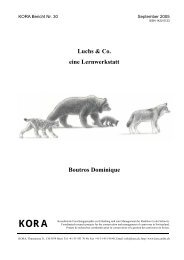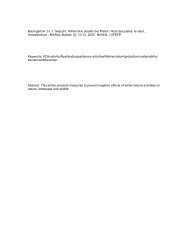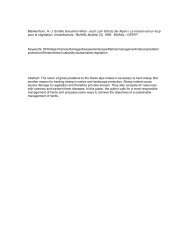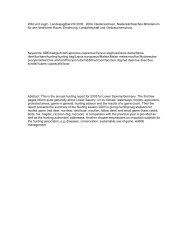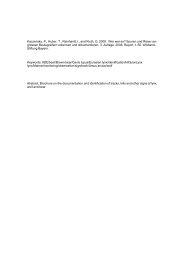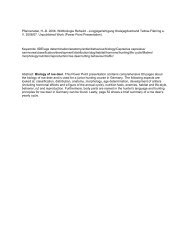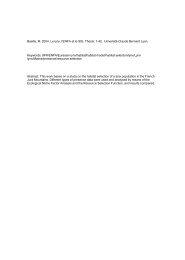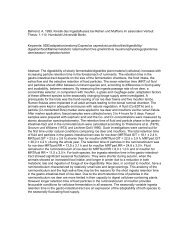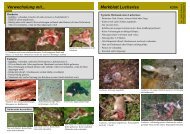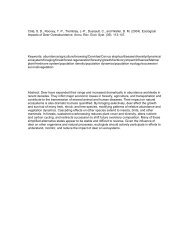20 DiscussionKORA <strong>Bericht</strong> Nr. 134. Discussion4.1. Description of coat pattern typesWerdelin & Olsson (1997) coded felid coat patternsinto six discrete categories: flecks (small spots not organizedinto patterns), rosettes (small spots arrangedinto patterns of six or fewer spots), small blotches(small irregularly shaped areas of dark on a usuallylighter background), blotches (large areas of variablecolor framed by dark and set on a lighter background),vertical stripes (dark, dorsoventrally or anterodorsallyposteroventrallydirected stripes on a lighter background)and uniform (no distinguishable pattern)(Figure 13). My definitions of the five coat patterntypes corresponds to Werdelin & Olsson’s followingtypes: type 1 and 2, “large and small spots” correspondto “flecks”; type 3, “without spots” to “uniform”;type 4a, “clear rosettes (small blotches) to“small blotches” and type 4b “small spots with rudimentaryrosettes” correspond to “rosettes” (Figure 14).Werdelin and Olsson (1997) looked at the coat patternsof living cat species in conjunction with the evolutionaryrelationship within the cat family to estimatehow often each type of pattern had given rise to each ofthe others and used clad. meth. of phyl. inf. to reconstructhistorical events in a phylogenetic framework.Because small flecks gave rise to large spots, rosettes,stripes and blotches much more frequently than any ofthe other possible transitions, they suggest that thecommon ancestor of modern cats, rather than havinglarge spots which broke apart later, was patterned withsmall flecks. As cats evolved, the flecks coalesced intolarger blotches, rosettes or stripes. Lynx coat patternmay have developed after this hypothesis. On the otherhand, Weigel (1961) proposed a felid coat pattern evolutionfrom a primitive form with large spots to smallerspots spacing into rosettes, and then striped patternsmay have developped (Figure 15).4.2. Comparisons with other descriptions of coatpatterns in lynxSeveral authors observed and described different coatpatterns of Eurasian lynx during the last century (Table4). Most of them observed three different types of patterns:large spots, small spots and without spots but therosette-spotted types has not been described in details.The descriptions differ widely. Only the large spottedtype was always exactly recognized and described. Inmost of the descriptions variations of the same typewere defined as other types. Grégorova (1997) defineda hypothesis about a new type of pattern: intermediate(rosettes) type. This type has hypothetically evolvedfrom hybridisation of a spotted and a non-spotted type.Different frequencies of coat patterns in the Eurasianlynx in different areas of its range were analyzedby several authors. The observed types were large-,small- or non-spotted. The frequencies differed immenselybut geographical trends have been found(Table 5). In the Carpathian Mts the large-spotted typeshowed a high frequency. In Western and NortheasternSiberia and in Central Asia type 3, withoutspots, was mostly observed. Type 2 showed generally alow frequency.Figure 13. The six different coat patterns in felids. Left column, top to bottom, flecks, rosettes, verticalstrips; right column, top to bottom, small blotches, blotches, uniform. After Werdelin & Olsson (1997).
Juni 2002 Discussion21Figure 14. The four different types of spots in lynx coat patterns: spots correspond to flecks, (included smalland large spots), without spots correspond to uniform, clear rosettes (small blotches) correspond to smallblotches and rosettes or rudimentary rosettes correspond to rosettes. Left pictures top to bottom after Werdelin& Olsson (1997).4.3. Spatial and temporal distribution of coat patternsin SwitzerlandIn 1971 the Eurasian lynx was re-introduced into theSwiss Alps and initially, had spread quite fast over thewestern Alps and the Jura Mts but since the mid 1980s,the population expansion came to a halt, even thoughthere were still large areas of suitable habitat not yetoccupied in eastern Switzerland (Breitenmoser 1983,Haller 1992). Though the re-introduced individuals inthe Jura Mts and population of the Swiss Alps originatedfrom the same source population, the CarpathianMts of Slovakia, the development of the frequency indifferent coat pattern types differed widely. Before theextermination the range of the Eurasian lynx extendedthroughout Europe (Nowell & Jackson 1996) thereforethe historic Swiss population belonged to the sameCarpathian population as the Slovakian population.The change of the occurrence of different types developedfrom type 3, without spots, in the historical populationto type 1, large spots, in the early re-introducedpopulation, then to type 2, small spots, and finally totype 4a and 4b, rosettes and rudimentary rosettes, inlate re-introduced or recent populations. Ragni (1993)analyzed coat patterns of the extinct Alpine population.



